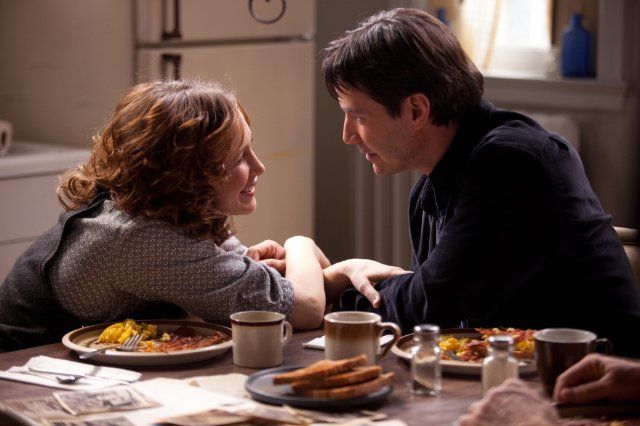

Henry’s Crime
The Depression had Bonnie and Clyde; Malcolm Venville’s recession-era heist flick introduces Henry. Blank-faced as ever, Keanu Reeves plays an aimless tollbooth operator in Buffalo, New York, who gets conned into being the unwitting getaway driver for a shady pal (the ever-suspicious-looking Fisher Stevens) on his way to a bank robbery. The real crooks get away, but Henry does three years in the clink and emerges with a why-the-hell-not dream: to rob the same bank. “I did the time,” Henry says, “I may as well have done the crime.” Since the bank is connected to a theater by an old Prohibition tunnel, the logical option is — natch — for Henry to woo an actress (Vera Farmiga) and connive his way onto the stage as The Cherry Orchard’s Lopahkin. With a marvelous James Caan starring as his old jailhouse roommate turned mentor, Henry’s Crime has the makings of a zippy caper comedy, but Reeves has never been zippy. However, his laconic rhythm does find a groove of its own, and the wickety-wacking throwback soundtrack by Sharon Jones and the Dap Kings plays counterpoint to Reeves’ blank-faced daze and stiff stillness and helps bring out the absurd humor in his rigor mortis deadpan. And fortunately, for a film that quotes so much Chekhov, Henry’s Crime is likably unpretentious: a wry story about a quiet schmuck who finally sticks his neck out. It slows down in the final third but holds together reasonably well until the very end, when it seems as if we’re supposed to see Reeves storm back onto the theater stage as a more self-actualized Lopahkin — but instead we get the same rigid Keanuian composure. Reeves has a stone face as blank as Buster Keaton’s, but maybe that face wasn’t meant for Chekhov.
Ceremony
If there were a karaoke bar for Wes Anderson acolytes, Ceremony’s first-time director Max Winkler would be the king of the open mike. In the Owen Wilson–Jason Schwartzman role, Michael Angarano plays Sam, an unself-conscious, motormouthed egotist in a crimson suit who drags his friend Marshall (Reece Thompson) along to the wedding of the much older girlfriend Zoe (Uma Thurman) who recently dumped him. There are also Andersonesque intimations of Salinger, slatherings of theatrical yuppie eccentricity, cute vintage automobiles and luggage, and a white character’s nonthreatening fetish for a mysterious woman of color. Winkler (the 27-year-old son of Henry, who’s directed episodes of the excellent online series Wainy Days and Clark and Michael) flaunts a sure touch with fast-moving, occasionally sharp dialogue and busy party scenes, but his film skitters over the surface like a crab on glass and the casting doesn’t work. Thurman isn’t just too old for Sam, she’s too assured as a screen presence to believe she might fall for a scrawny, obnoxious ass like Sam. Winkler has bet that he can make Angarano’s yammering prima donna so charming that he will be able to prattle on throughout the entire film and not wear out his welcome. But too often, the viewer — unlike the characters around him — prays for him to just shut the fuck up already. Winkler’s got talent, but he set such a difficult task for himself that it’s no surprise he failed to clear the high bar. As any student of karaoke knows, you just don’t do Whitney Houston your first time out. Even if you have a strong voice.
Blank City
In the late seventies, when the aggressive, anti-commercial experimental No Wave music scene emerged in New York (Sonic Youth, Lydia Lunch), a downtown filmmaking analog bubbled up alongside it, with such technique-averse directors as James Nares, Eric Mitchell, John Lurie, Susan Siedelman, Bette Gordon, and Jim Jarmusch. In this banging, bumpy ride of a documentary, director Celine Danhier argues for the importance of these filmmakers, even as she illustrates how they barely had a coherent cinematic aesthetic besides an affinity for cheap 16mm, non-professional actors, and the back table at Max’s Kansas City. Beginning in 1976 with Amos Poe’s punk doc Blank Generation and proto-indie Unmade Beds (starring a shock-headed Debbie Harry as a mob moll), these films mashed up genres, indulged in and thrashed through the archness of camp, pushed sexual boundaries, and pursued a self-documenting, post-bohemian search for leather-jacketed cool that most would now (unfairly) dismiss as hipsterism. Today, the films work both as documents of a short-lived scene and the birth of a loosely defined New York sensibility that was at once smart-assed and goofy, sophisticated and cockily naïve. Danhier’s savvy documentary grabs all the right interviews (from Steve Buscemi to Jarmusch and Fab Five Freddy) and would be worthy just for its condensed, montage tour through this creative eruption, but it also amplifies the relatively unsung role of female filmmakers, and tracks how this lo-fi mini-movement set off a daisy chain of artistic explosions, from Charlie Ahearn’s graffiti-scene cult classic Wild Style to the mostly obnoxious Cinema of Transgression (which seems to encapsulate and punctuate downtown’s most indulgent prurience). No Wave artists pushed a black-clad, skinny-hipped posture that young artists are still emulating, and as digital cinema explodes and boundaries between music and film and interactive fall, more young filmmakers are following that No Wave, low-budget, by-any-means, amateur-in-the-best-sense approach. No Wave filmmakers claimed their work was born out of an angry, nihilistic “no,” but their legacy — and this vital documentary — suggests that they also opened up a whole other way of saying “yes.”

